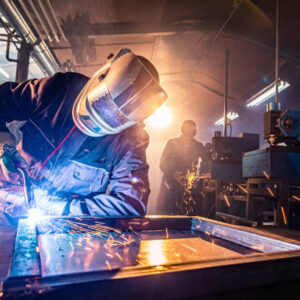In India, aging buildings and poor maintenance have become a growing concern. Many RCC structures exhibit visible cracks, sagging, or even signs of corrosion. These issues not only reduce structural strength but also pose serious safety risks. Property owners, engineers, and contractors often seek a reliable, cost-effective method to restore damaged slabs. Slabs jacketing has emerged as one of the most efficient and trusted strengthening solutions for such cases.
1. Enhances Load-Bearing Capacity
Slabs’ capacity to support weights drastically decreases as they begin to deteriorate. Older slabs may become stressed by increased use, remodelling, or the addition of extra floors. Slab jacketing is crucial in these situations. It increases the initial load-bearing capability by using reinforced layers. This increases the structure’s safety, particularly in urban Indian buildings that weren’t built to support such loads in the first place. Stability is thereby restored without requiring complete destruction or rebuilding.
2. Cost-Effective Repair Solution
Slab reconstruction is costly and time-consuming. Whole slabs can be extremely expensive to break, remove, and rebuild. In India, this is especially challenging for hospitals, schools, and residential communities. Thankfully, slab jacketing offers a less expensive option. At a fraction of the price, it strengthens and fixes the slab. Property owners are able to devote expenditures to other important building sections because it requires less time and supplies.
3. Minimally Disruptive to Occupants
It is not feasible to remove tenants for repairs in India’s crowded cities. People find it difficult to move, whether they are in a bustling commercial building or a home apartment. Slab jacketing has the benefit of being able to be done with little disruption. The majority of the work can be done from beneath the slab without interfering with regular business activities. Because of its ease of use, it is the method of choice for occupied buildings and spaces.
4. Increases Slab Durability
Over time, old concrete becomes brittle. Wear and tear is accelerated by exposure to chemicals, water, and load variations. By covering the damaged area with more robust material, slab jacketing solves this issue. Polymer-modified mixtures or high-strength micro-concrete are frequently utilized. By creating a protective shell, this greatly extends the slab’s lifespan. It guarantees long-term serviceability and lessens future deterioration, particularly in regions like India where RCC is impacted by heat and monsoon cycles.
5. Prevents Progressive Cracking
Over time, old concrete becomes brittle. Wear and tear is accelerated by exposure to chemicals, water, and load variations. By covering the damaged area with more robust material, slab jacketing solves this issue. Polymer-modified mixtures or high-strength micro-concrete are frequently utilized. By creating a protective shell, this greatly extends the slab’s lifespan. It guarantees long-term serviceability and lessens future deterioration, particularly in regions like India where RCC is impacted by heat and monsoon cycles.
6. Improves Earthquake Resistance
There are seismic zones in a number of Indian locations. Buildings in regions like Gujarat, Maharashtra, and portions of the Northeast need to be able to withstand earthquakes. Updated codes might not apply to older RCC structures. Jacketing slabs can enhance their seismic performance. During earthquake activity, it increases ductility and more uniformly redistributes loads. Slabs that have been strengthened are less prone to collapse, particularly if they are retrofitted with beams and columns. It is a crucial component of earthquake resistance.
7. Strengthens Corroded Reinforcement
Corrosion of reinforcement is a silent danger. Rusting is accelerated by water intrusion, inadequate concrete covering, or elevated chloride levels. Rust spreads and erodes the nearby concrete over time. This issue frequently arises in high-rainfall areas and coastal towns in India. The old steel is cleaned and protected with slab jacketing. In order to regain strength, fresh reinforcement is also added. Future corrosion is also reduced with bonding agents and protective coatings.
8. Extends Structure Lifespan
It is anticipated that Indian buildings would last for decades. However, after only 20 to 30 years, many begin to exhibit distress. It is not feasible to rebuild them every few decades. The prolongation of service life is one of the main benefits of slab jacketing. When done correctly, it can extend a slab’s useful life by 20 to 25 years. For workplaces, schools, and other structures in society that cannot afford complete replacements, this makes it a wise investment.
9. Environmentally Responsible Option
In India, sustainable building is becoming more and more popular. Green building principles support repairing rather than tearing down. Compared to slab removal, slab jacketing generates far less waste. It lowers the use of raw materials such as steel, sand, and cement. Debris handling and material transportation use less energy. This environmentally friendly strategy lowers the carbon footprint of the building sector and advances India’s long-term sustainability objectives.
10. Supports Structural Retrofitting Programs
All around India, individual owners and government organizations are starting retrofitting projects. Safety improvements are required for aging bridges, offices, hospitals, and public structures. For these projects, slab jacketing is essential. It fortifies current flooring without sacrificing style. Above all, it enables buildings to comply with updated safety and load requirements. It is a useful element in the structural engineer’s arsenal for any retrofitting project.
11. Compatible with Other Strengthening Methods
Slabs can require more than one repair method. Additionally, they can need external supports, column jacketing, or beam jacketing. When paired with slabs, jacketing looks great. It blends in well with bonded overlays or fiber wrapping. This compatibility is essential in India, where historic buildings sometimes require several renovations. It guarantees that the repair system functions as a single, integrated system, lowering risk and increasing effectiveness.
12. Boosts Property Value and Safety Perception
It is simpler to sell, lease, or insure a building that is structurally solid. Slabs that are cracked or sagging deter potential tenants and buyers. Restoring confidence in the building’s safety is achieved through slab jacketing. It removes obvious defects and gives residents, investors, and inspectors peace of mind. Improved buildings are more valuable in India’s cutthroat real estate markets. This technique becomes a crucial component of property improvement for societies preparing for redevelopment or sales.
In India, buildings must contend with issues like aging, water damage, and seismic hazards. However, it is not possible nor economical to tear down and rebuild every shaky slab. Slabs jacketing provides a compromise in this situation. It strengthens, fixes structural damage, and extends the life of buildings. It is quickly becoming the preferred method for reinforcing RCC slabs due to its long-term advantages and little disturbance.
Regardless of your background—property owner, engineer, or member of the community—this approach merits careful thought. The better the result, the sooner the repair is made. Strength and safety should never be postponed.

